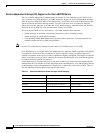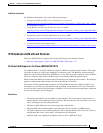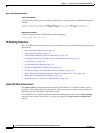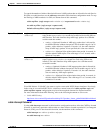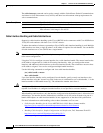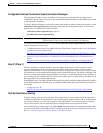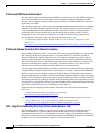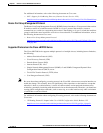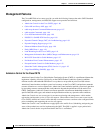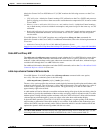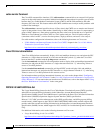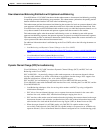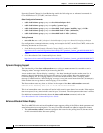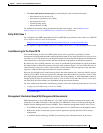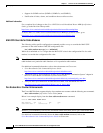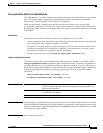
1-86
Cisco uBR7200 Series Universal Broadband Router Software Configuration Guide
OL-2239-05
Chapter1 Overview of Cisco uBR7200 Series Software
cops tcp window-size
Management Features
The Cisco uBR7200 series routers provide you with the following features that make CMTS headend
configuration, management, and DOCSIS support more powerful and efficient:
• Admission Control for the Cisco CMTS, page 1-86
• Cable ARP and Proxy ARP, page 1-87
• cable map-advance Command Enhancements, page 1-87
• cable monitor Command, page 1-88
• Cisco IOS Internationalization, page 1-88
• DOCSIS 2.0 SAMIS ECR Data Set, page 1-88
• Dynamic Channel Change (DCC) for Loadbalancing, page 1-89
• Dynamic Ranging Support, page 1-90
• Enhanced Modem Status Display, page 1-90
• Entity MIB, Phase 1, page 1-91
• Load Balancing for the Cisco CMTS, page 1-91
• Management Information Base (MIB) Changes and Enhancements, page 1-91
• MAX-CPE Override for Cable Modems, page 1-92
• Per-Modem Error Counter Enhancements, page 1-92
• Pre-equalization Control for Cable Modems, page 1-93
• Subscriber Traffic Management (STM) Version 1.1, page 1-95
• Usage Based Billing (SAMIS), page 1-96
Admission Control for the Cisco CMTS
Admission Control for the Cisco Cable Modem Termination System (CMTS) is a multifaceted feature that
implements a Quality of Service (QoS) policy on the CMTS Headend. Admission Control establishes
efficient resource and bandwidth utilization in a way that was not possible in prior Cisco IOS releases.
Admission Control monitors multiple system-level resources on the Cisco CMTS, and performs automatic
resource allocation on a service-request basis. Admission Control maintains optimal system-level operation
by preventing resource consumption that would otherwise degrade the performance for the entire Cisco
CMTS. Furthermore, Admission Control can allocate upstream or downstream bandwidth resources to
specific DOCSIS traffic types, and maintain such prioritization amidst very dynamic traffic conditions.
Admission Control uses two event types for resource monitoring and management—cable modem
registration and dynamic service (voice call) requests. When either of these two events occurs on the
Cisco CMTS, Admission Control verifies that the associated resources conform to the configured limits
prior to admitting and supporting the service call request.
Admission Control is not a mechanism to apply QOS to the traffic flows. Scheduling and queuing are
some of the mechanisms used for implementing the QOS. The QOS is applied on per packet basis.
Admission Control checks are performed before the flow is committed.



